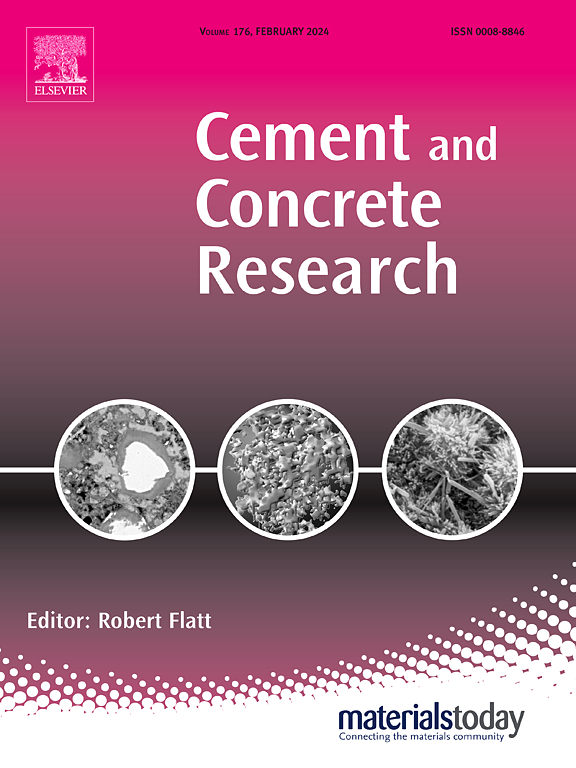高co2环境下水泥生料的物相演化
IF 10.9
1区 工程技术
Q1 CONSTRUCTION & BUILDING TECHNOLOGY
引用次数: 0
摘要
本研究利用高温x射线衍射(HT-XRD)研究了高co2气氛对水泥生料相演化、可燃性和熟料矿物形成的影响。水泥工业是一个重要的二氧化碳排放源,主要来自石灰石分解和燃料燃烧。碳捕获与封存(CCS)等创新解决方案至关重要,电气化和全氧燃料燃烧也很有前景。等离子体技术采用二氧化碳作为载气,为接近零排放提供了一条途径。在常规(20%二氧化碳)和高二氧化碳(95%二氧化碳)条件下分析了来自北欧的四种工业生食。化学成分、粒度分布和粗馏分分析在温度高达1500°C时进行了HT-XRD数据收集。高co2条件延迟方解石分解,降低游离cao的可用性,改变可燃性。方解石分解相对于C2S形成的时间表明,从方解石中释放的游离CaO与热活化的SiO2快速反应生成C2S的反应途径。此外,在富含刺激石的样品中,刺激石分解释放出活性CaO和C2S,在1300-1400℃时促进了C3S的形成。在1400°C以上,熔体的形成促进了C3S的进一步发展,导致两种测试大气中的最终水平相似。这些结果表明,高co2条件显著影响熟料的相演化和反应性。实际意义包括优化电气化和全氧燃料系统的生料成分和窑炉温度分布,以提高可燃性,同时最大限度地减少诸如刺石引起的窑炉堆积等操作问题。未来的研究应进一步探索工业可扩展性和原料调整,以提高熟化过程中的CO2效率。本文章由计算机程序翻译,如有差异,请以英文原文为准。


Phase evolution of cement raw meal in a high-CO2 atmosphere
This study investigates the effects of a high-CO2 atmosphere on phase evolution, burnability, and clinker mineral formation in cement raw meals using high-temperature X-ray diffraction (HT-XRD). The cement industry is a significant CO2 emitter, primarily from limestone decomposition and fuel combustion. Innovative solutions such as carbon capture and storage (CCS) are critical, with electrification and oxy-fuel combustion showing promise. Electrification using plasma technology, which employs CO2 as a carrier gas, offers a pathway to near-zero emissions.
Four industrial raw meals from northern Europe were analyzed under conventional (20% CO2) and high-CO2 (95% CO2) conditions. Chemical composition, particle size distribution, and coarse fraction analyses preceded HT-XRD data collection across temperatures up to 1500 °C. High-CO2 conditions delayed calcite decomposition, reducing free-CaO availability and altering burnability. The timing of calcite decomposition relative to C2S formation suggests a reaction pathway in which free CaO, released from calcite, rapidly reacts with thermally activated SiO2 to form C2S. Additionally, spurrite decomposition released reactive CaO and C2S, enhancing C3S formation at 1300–1400 °C in spurrite-rich samples. Above 1400 °C, melt formation promoted further C3S development, leading to similar final levels in both tested atmospheres.
These findings indicate that high-CO2 conditions significantly influence clinker phase evolution and reactivity. Practical implications include optimizing raw meal composition and kiln temperature profiles in electrified and oxy-fuel systems to enhance burnability while minimizing operational issues such as spurrite-induced kiln buildup. Future research should further explore industrial scalability and raw material adjustments to enhance CO2 efficiency during clinkerization.
求助全文
通过发布文献求助,成功后即可免费获取论文全文。
去求助
来源期刊

Cement and Concrete Research
工程技术-材料科学:综合
CiteScore
20.90
自引率
12.30%
发文量
318
审稿时长
53 days
期刊介绍:
Cement and Concrete Research is dedicated to publishing top-notch research on the materials science and engineering of cement, cement composites, mortars, concrete, and related materials incorporating cement or other mineral binders. The journal prioritizes reporting significant findings in research on the properties and performance of cementitious materials. It also covers novel experimental techniques, the latest analytical and modeling methods, examination and diagnosis of actual cement and concrete structures, and the exploration of potential improvements in materials.
 求助内容:
求助内容: 应助结果提醒方式:
应助结果提醒方式:


